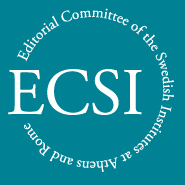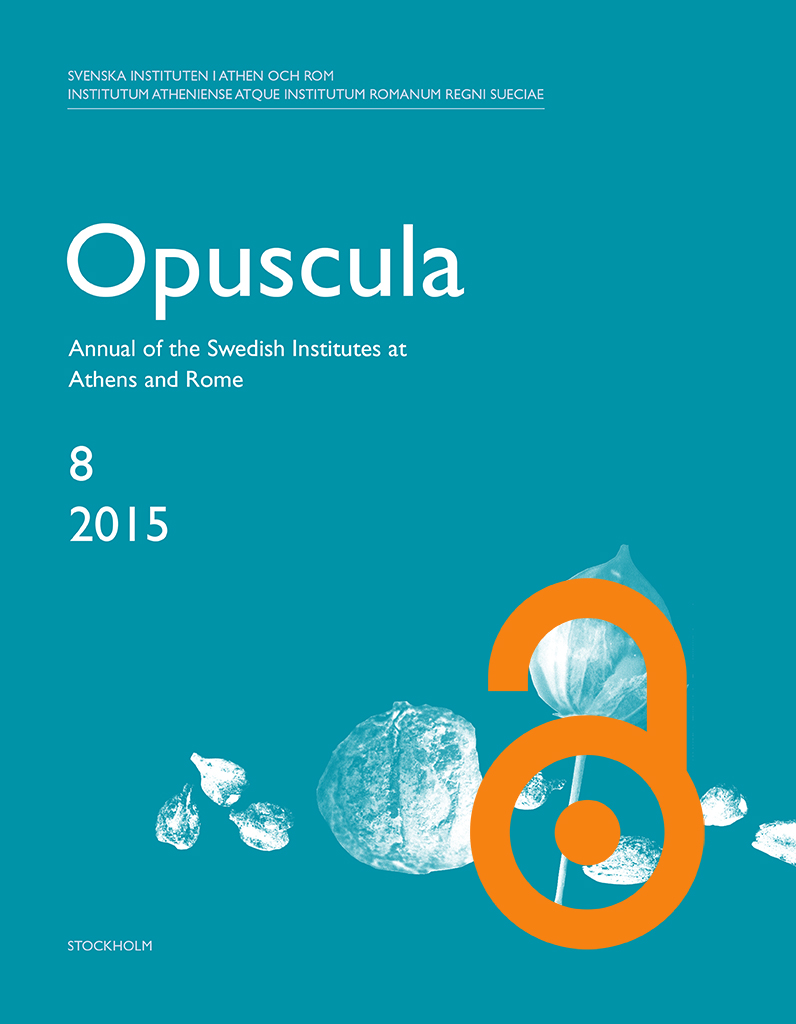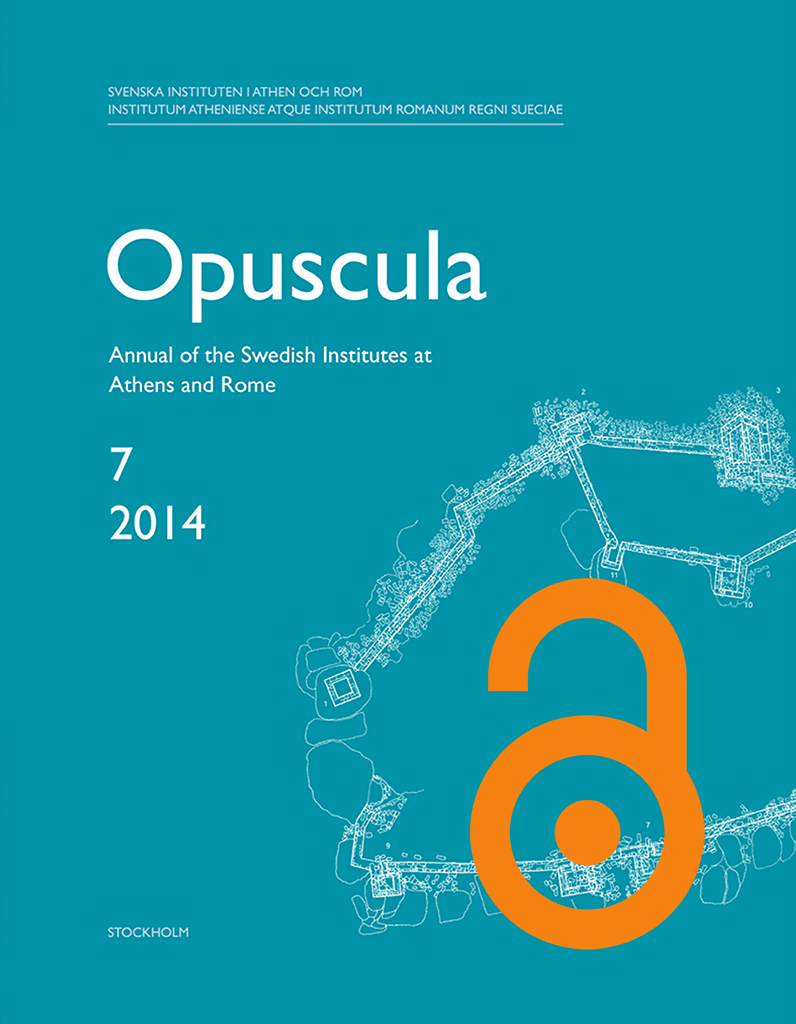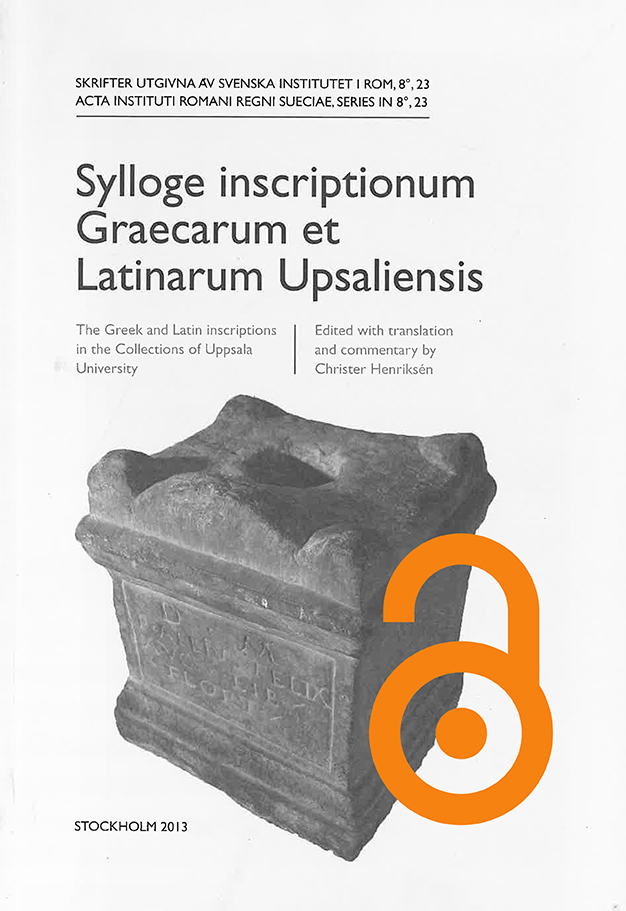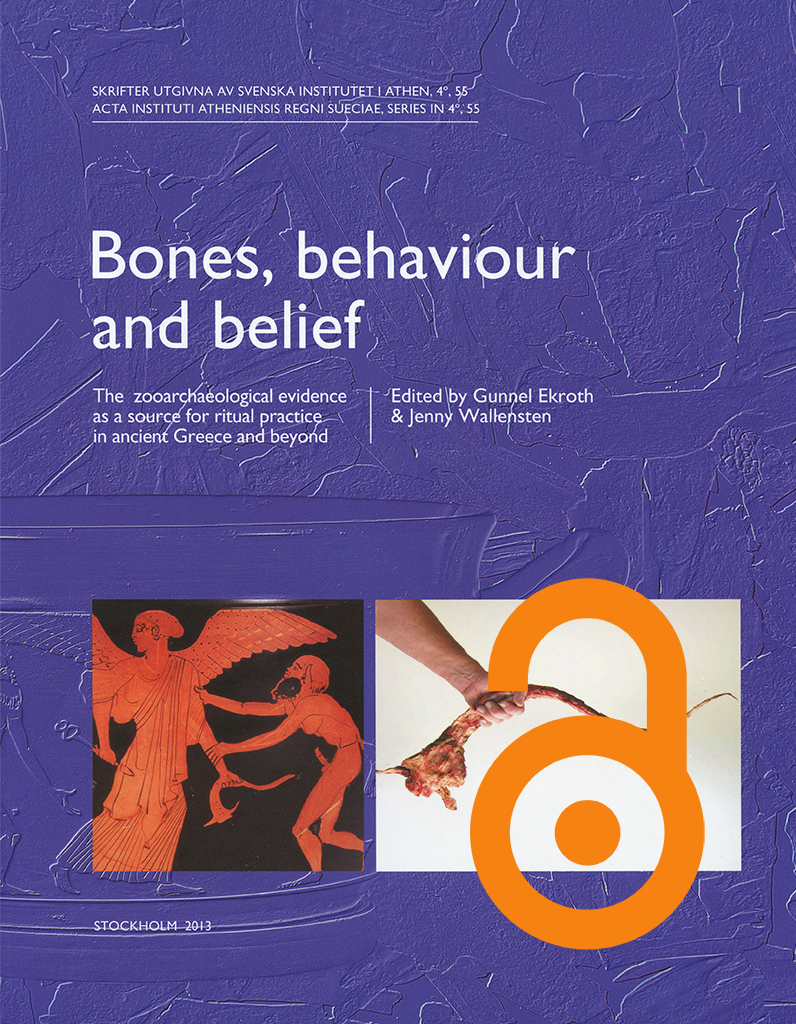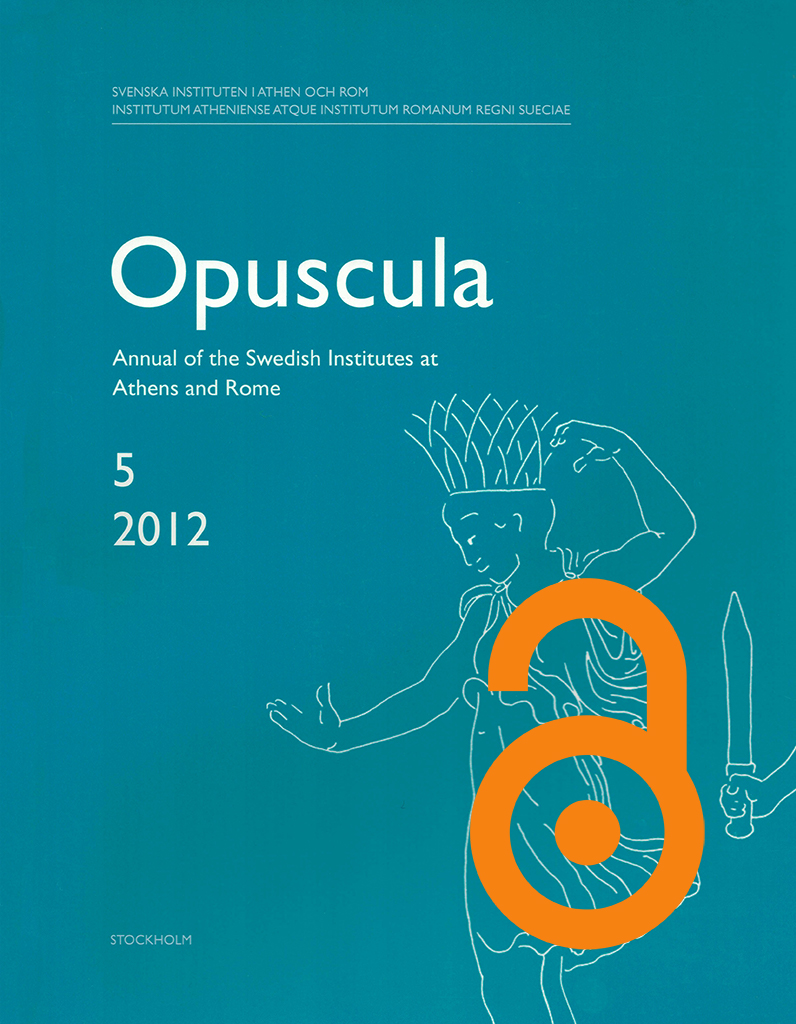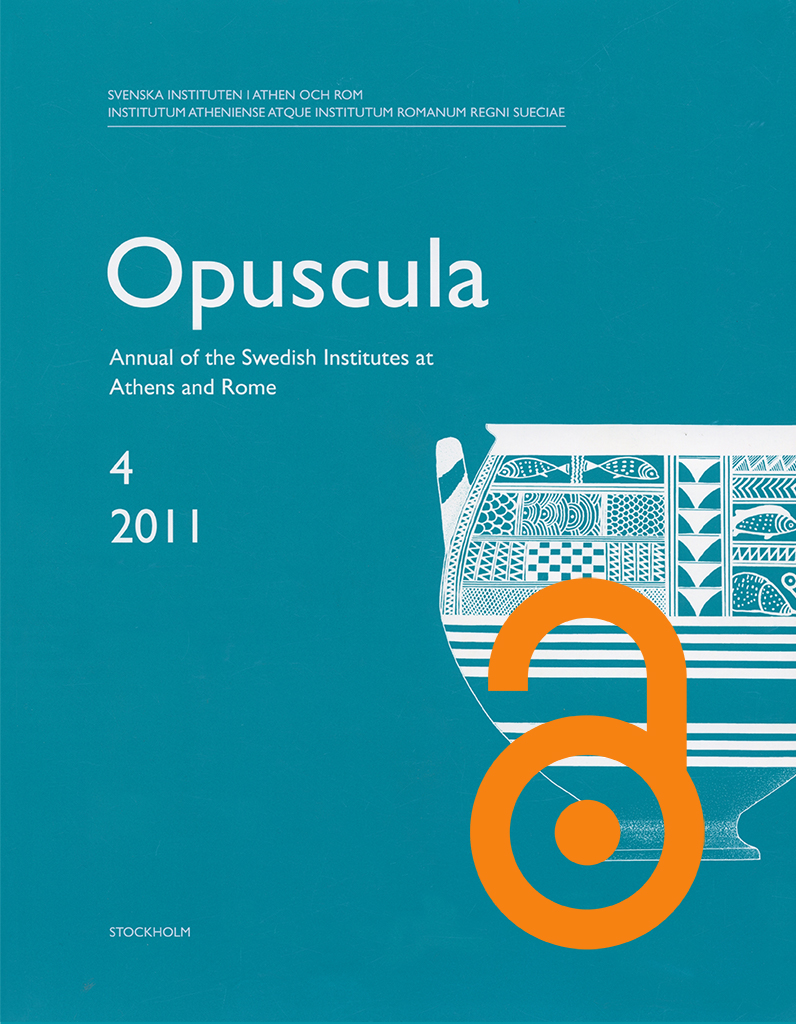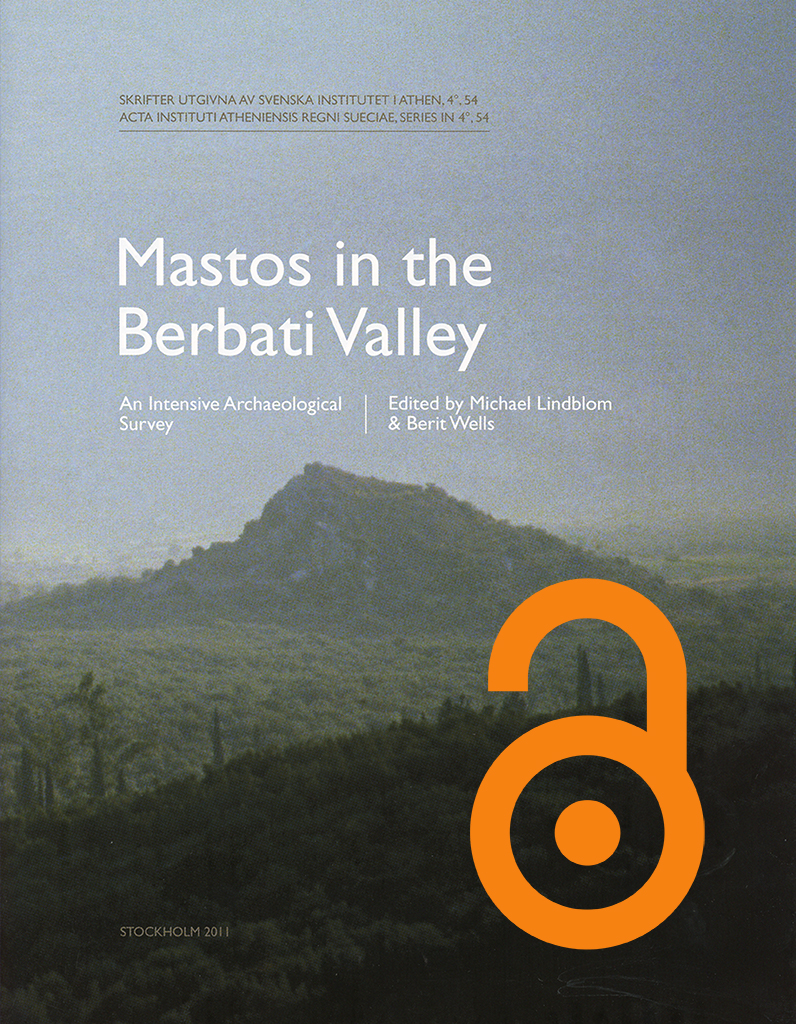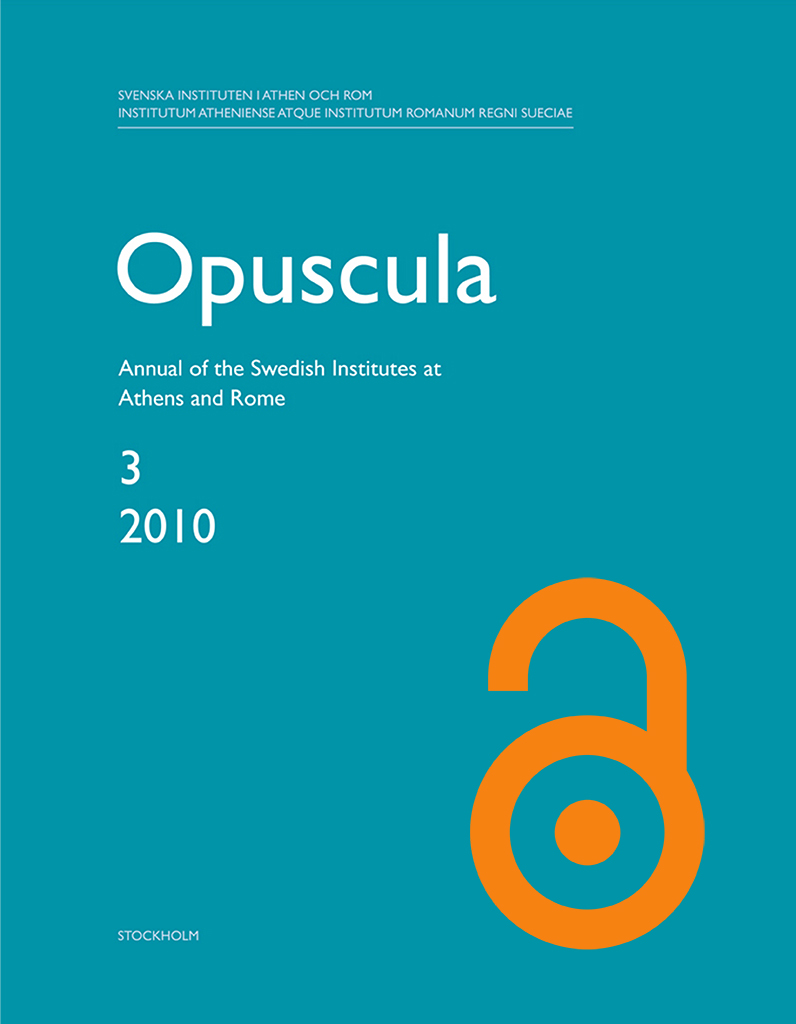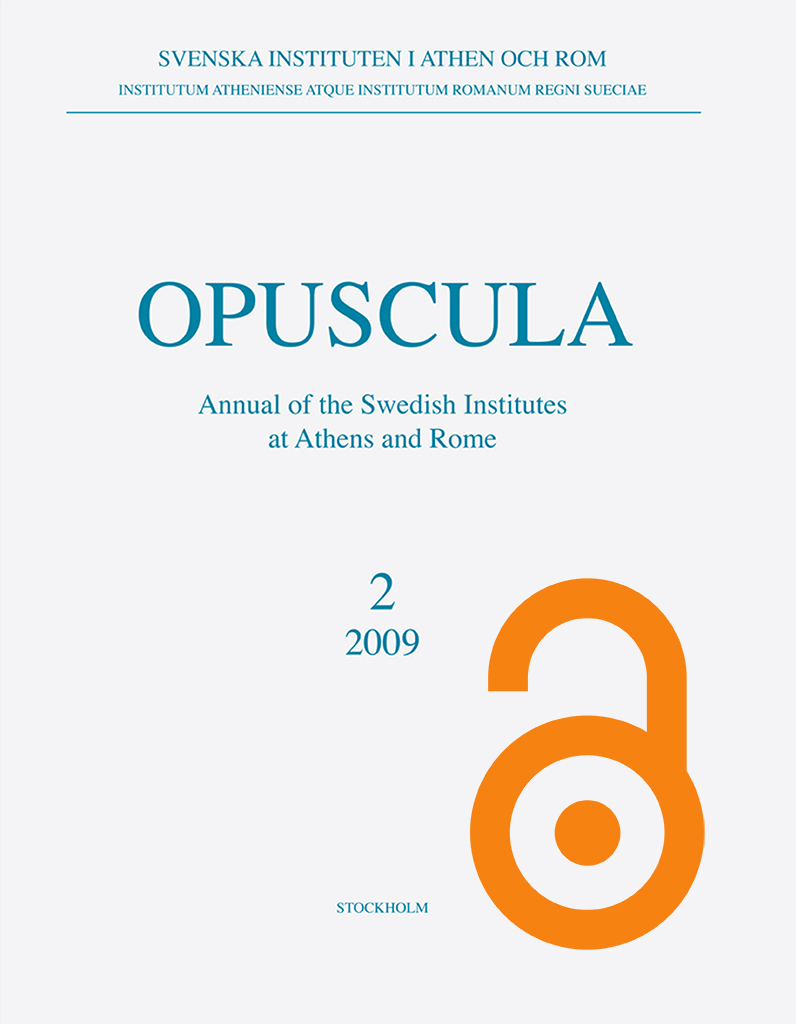All content available with open access, use links below. Printed edition distributed by eddy.se AB at Bokorder.se. Also available at Amazon.com, Bokus.com and Adlibris.com. View this volume at ERIH PLUS. Contents John K. Papadopoulos | The Charitonidis Class. A group of large Athenian Late Protogeometric skyphoi Peter M. Fischer & Teresa Bürge | The New Swedish Cyprus Expedition 2014. Excavations at Hala Sultan Tekke. Preliminary results. With contributions by B. Stolle, I. Trinks, L. Mazzotta & L. Recht, A. Lindqvist & D. Kofel Vassos Karageorghis & Efstathios Raptou | Two new Proto-White Painted ware vases of the pictorial style from Palaepaphos, Cyprus Susanne Berndt | Cutting the Gordian knot. The iconography of Megaron 2 at Gordion Hedvig Landenius Enegren | Loom weights in Archaic South Italy and Sicily. Five case studies Peter M. Fischer & Teresa Bürge | The Swedish Jordan Expedition 2014 at Tall Abu al-Kharaz. Preliminary results from Areas 12 and 13 Gregor Maurach | Terenz’ Hecyra – Spiel der Voreiligkeiten Book reviews Bibliographical information Opuscula. Annual of the Swedish Institutes at Athens and Rome (OpAthRom) 8, Stockholm 2015. ISSN: 2000-0898. ISBN: 978-91-977798-7-6. Softcover, 196 pages. https://doi.org/10.30549/opathrom-08.
All content available with open access, use links below. Printed edition distributed by eddy.se AB at Bokorder.se. Also available at Amazon.com, Amazon.de, Bokus.com and Adlibris.com. View this volume at ERIH PLUS. Contents Chiara M. Mazzeri | Ancestors at the gate. Form, function and symbolism of the imagines moiorum. A comparative analysis of Etruscan and Roman funerary art Lars Karlsson, Jesper Blid Kullberg, Baptiste Vergnaud & Agneta Freccero | Labraunda 2012-2013. A preliminary report on the work at the sanctuary. With a new reconstruction drawing of the sanctuary by Jesper Blid Kullberg and an appendix by Fredrik Tobin Peter M. Fischer & Teresa Bürge | The New Swedish Cyprus Expedition 2013. Excavations at Hala Sultan Tekke. Preliminary results. With contributions by R. Árnadóttir M. Mehofer, F. Köstelbauer, A. Satraki, L. Mazzotta & A.Trecarichi, D. Blattner, B. Stolle & A. Miltiadous Johansson Svante Fischer | The solidus hoard of Casa delle Vestali in context Peter M. Fischer & Teresa Bürge | The Swedish Jordan Expedition 2013 at Tall Abu al-Kharaz. Preliminary results from Areas 9, 10 and 11 Arto Penttinen & Jenny Wallensten | Berit Wells in memoriam Gunnel Ekroth | Castration, cult and agriculture. Perspectives on Greek animal sacrifice Charlotte Scheffer…
All content available with open access, use links below. Printed edition distributed by eddy.se AB at Bokorder.se. Also available at Amazon.com, Amazon.de, Bokus.com and Adlibris.com. View volume at ERIH PLUS. Contents Jan N. Bremmer | The agency of Greek and Roman statues. From Homer to Constantine Margareta Strandberg Olofsson | Fragments with horses and wolf’s teeth. Black impasto and its association with periods and buildings in the monumental area at Acquarossa Peter M. Fischer & Teresa Bürge | The New Swedish Cyprus Expedition 2012. Excavations at Hala Sultan Tekke. Preliminary results. With contributions by I. Trinks, B. Stolle, K. Heiß, J.A.I. van der Does & D.M. Blattner Alexandra Alexandridou | Archaic pottery and terracottas from the Sanctuary of Poseidon at Kalaureia Jörg Weilhartner | Textual evidence for Aegean Late Bronze Age ritual processions Ann Brysbaert & Melissa Vetters | A moving story about exotica. Objects’ long-distance production chains and associated identities at Tiryns, Greece Maria-Foteini Papakonstantinou, Arto Penttinen, Gregory N. Tsokas, Panagiotis I. Tsourlos, Alexandros Stampolidis, Ilias Fikos, Georgios Tassis, Konstantina Psarogianni, Lambros Stavrogiannis, Anton Bonnier, Monica Nilsson, Henrik Boman | The Makrakomi Archaeological Landscapes Project (MALP). A preliminary report on investigations carried out in 2010-2012 Kerstin Höghammar | On the…
Open access. Printed edition distributed by Eddy.se AB. Also available at Amazon.com, Amazon.de and Adlibris. Sylloge inscriptionum Graecarum et Latinarum Upsaliensis. The Greek and Latin inscriptions in the Collections of Uppsala University By Christer Henriksén (ed.) The present book is the first complete edition of the 24 Greek and Latin inscriptions in the Collection of Classical Antiquities and the Victoria Museum of Uppsala University. It contains an introduction that discusses the various types of inscriptions represented in the collections, their probable provenance and their history as part of the Uppsala collections. After the introduction follows the actual edition, which consists of a new reading of text of each inscription, followed (where possible) by an English translation, a summary of its physical and palaeographical features, and a line-by-line commentary. The commentary explains each text with regard to its contents and discusses points of linguistic, phraseologic, and onomastic interest. Inscriptions of particular interest are provided with separate introductions that place them in a wider historical and social context. While the commentary is intended to be useful both to specialists in epigraphy as well as to the general classicist, it also aims at providing such information that may interest the general public. The…
Now available for purchase and free download at Bokorder.se. Also available at Amazon.com, Amazon.de, Bokus.com and Adlibris.com. Bones, behaviour and belief. The zooarchaeological evidence as a source for ritual practice in ancient Greece and beyond Edited by Gunnel Ekroth & Jenny Wallensten https://doi.org/10.30549/actaath-4-55 The importance of the zooarchaeological evidence as a source for ritual practices in ancient Greece is gradually becoming widely recognized. Animal bones form the only category of evidence for Greek cult which is constantly significantly increasing, and they can complement and elucidate the information provided by texts, inscriptions and images. This volume brings together sixteen contributions exploring ritual practices and animal bones from different chronological and geographical perspectives, foremost ancient Greece in the historical period, but also in the Bronze Age and as early as the Neolithic period, as well as Anatolia, France and Scandinavia, providing new empirical evidence from a number of major sanctuaries and cult-places. On a methodological level, the complexity of identifying ritual activity from the zooarchaeological evidence is a recurrent theme, as is the prominence of local variation visible in the bone material, suggesting that the written sources and iconography may offer simplified or idealized versions of the rituals actually performed. Although zooarchaeology…
All content available with open access, use links below. Printed edition distributed by eddy.se AB at Bokorder.se. Also available at Amazon.com, Amazon.de, Bokus.com, and Adlibris.com. View this volume at ERIH PLUS. Contents Julia Habetzeder | Dancing with decorum. The eclectic usage of kalathiskos dancers and pyrrhic dancers in Roman visual culture Lars Karlsson, Jesper Blid & Olivier Henry | Labraunda 2011. A preliminary report on the Swedish excavations. With an appendix by R. Hedlund Peter M. Fischer | The New Swedish Cyprus Expedition 2011. Excavations at Hala Sultan Tekke. Preliminary results. With appendices by T. Bürge, L. Franz and R. Feldbacher Richard Ramanius | Euergetism and city-walls in the Italian city of Telesia Paavo Roos | The water-mills on the Lamas River in Cilicia Julia Habetzeder | The impact of restoration. The example of the dancing satyr in the Uffizi Peter M. Fischer | The Swedish Jordan Expedition 2009 and 2010 at Tall Abu al-Kharaz. Preliminary results from the Early Iron Age occupation in Area 9. With appendices by T. Bürge, A. Gustafsson & J. Azzopardi Book reviews Bibliographical information Opuscula. Annual of the Swedish Institutes at Athens and Rome (OpAthRom) 5, Stockholm 2012. ISSN: 2000-0898. ISBN: 978-91-977798-4-5. Softcover, 204…
All content available with open access, use links below. Printed edition distributed by eddy.se AB at Bokorder.se. Also available at Amazon.com, Amazon.de, Bokus.com, and Adlibris.com. View this volume at ERIH PLUS. Contents Henrik Gerding | A courtyard gate at Thourioi Lars Karlsson, Jesper Blid & Olivier Henry | Labraunda 2010. A preliminary report on the Swedish excavations Peter M. Fischer | The New Swedish Cyprus Expedition 2010. Excavations at Dromolaxia Vizatzia/Hala Sultan Tekke. Preliminary results. With appendices by P. Klingborg, F. & F. Kärfve, C. Hagberg, O. Svensson, S. Macheridis & L. Franz Cecilia Olovsdotter | Representing consulship. on the conception and meanings of the consular diptychs Petra Pakkanen | Is It Possible to Believe in Syncretistic God? Discussion on Conceptual and Contextual Aspects of Ancient Greek Syncretism Anna Holst Blennow & Frederick Whitling | Italian dreams, Roman longings. Vilhelm Lundström and the first Swedish philological-archaeological course in Rome, 1909 Book reviews Bibliographical information Opuscula. Annual of the Swedish Institutes at Athens and Rome (OpAthRom) 4, Stockholm 2011. ISSN: 2000-0898. ISBN: 978-91-977798-3-8. Softcover, 173 pages. https://doi.org/10.30549/opathrom-04.
Open access, use links below. Printed edition distributed by Eddy.se AB. Also available at Amazon.com, Amazon.de, Bokus.com, and Adlibris.com. Mastos in the Berbati Valley. An intensive archaeological survey By Michael Lindblom & Berit Wells (eds.) This study presents the results of a small but intensive surface survey conducted on the Mastos Hill in the Berbati Valley in 1999. While remains from the Early and Late Helladic period were known from previous excavations on its southern and eastern slopes, this is the first analysis of the entire hill. It includes a digital documentation of the local topography as well as an account of the archaeological remains retrieved in the field. The study fills a gap in different data sets and results gained through old excavations and the extensive 1988–1990 Berbati-Limnes survey. The introductory chapter summarizes previous work in the valley, discusses its ancient routes of communication and outlines the method employed in the archaeological survey. This is followed by an account of the topographical survey and the geographical information system used. In the six following chapters the archaeological remains are presented and analyzed in a diachronic fashion. It is concluded that the hill was predominantely settled in prehistory with the exception…
All content available with open access, use links below. Printed edition distributed by eddy.se AB at Bokorder.se. Also available at Amazon.com, Amazon.de, Bokus.com, and Adlibris.com. View this volume at ERIH PLUS. Contents Katie Demakopoulou, Nicoletta Divari-Valakou, Maria Lowe Fri, Madeleine Miller, Monica Nilsson & Ann-Louise Schallin | Excavations in Midea 2008-2009 John K. Papadopoulos | The bronze headbands of prehistoric Lofkënd and their Aegean and Balkan connections Maria Gabriella Scapaticci | Un inedito lastrone a scala da Tarquinia presso l’Antiquiarum di Monte Romano Lars Karlsson | Labraunda 2009. A preliminary report on the Swedish excavations with contributions by Jesper Blid and Olivier Henry Anne-Marie Leander Touati | Water, well-being and social complexity in Insula V 1. A Pompeian city block revisited Julia Habetzeder | Marsyas in the garden? Small-scale sculptures referring to Marsyas in the forum Fernando Gilotta | Chiusi e il Clusium Group. Un nuovo documento dagli scavi di Orvieto Erika Weiberg | Pictures and people. Seals, figurines and Peloponnesian imagery Book reviews Bibliographical information Opuscula. Annual of the Swedish Institutes at Athens and Rome (OpAthRom) 3, Stockholm 2010. ISSN: 2000-0898. ISBN: 978-91-977798-2-1. Softcover, 224 pages. https://doi.org/10.30549/opathrom-03.
All content available with open access, use links below. Printed edition distributed by eddy.se AB at Bokorder.se. Also available at Amazon.com, Amazon.de, Bokus.com and Adlibris.com. View this volume at ERIH PLUS. Contents Katie Demakopoulou, Nicoletta Divari-Valakou, Monica Nilsson & Ann-Louise Schallin | Excavations in Midea 2007 Sofia Voutsaki, Søren Dietz & Albert J. Nijboer | Radiocarbon analysis and the history of the East Cemetery, Asine Lars Karlsson | Labraunda 2008. A preliminary report on the Swedish excavations with contributions by Jesper Blid and Olivier Henry Arto Penttinen, Berit Wells, Dimitra Mylona, Petra Pakkanen, Jari Pakkanen, Arja Karivieri, Anne Hooton, Emanuel Savini | Report on the excavations in the years 2007 and 2008 southeast of the Temple of Poseidon at Kalaureia Appendix: Tatiana Theodoropoulou | The sea-shells from the excavations in Area H in the Sanctuary of Poseidon at Kalaureia in 2007 and 2008 Berit Wells | A smiting-god-figurine found in the Sanctuary of Poseidon at Kalaureia Appendix: Andreas Karydas | In situ analysis of a bronze figurine in the Poros Archaeological Museum Jenny Wallensten & Jari Pakkanen | A new inscribed statue base from the Sanctuary of Poseidon at Kalaureia Jari Pakkanen | A tale of three drums: An unfinished…
